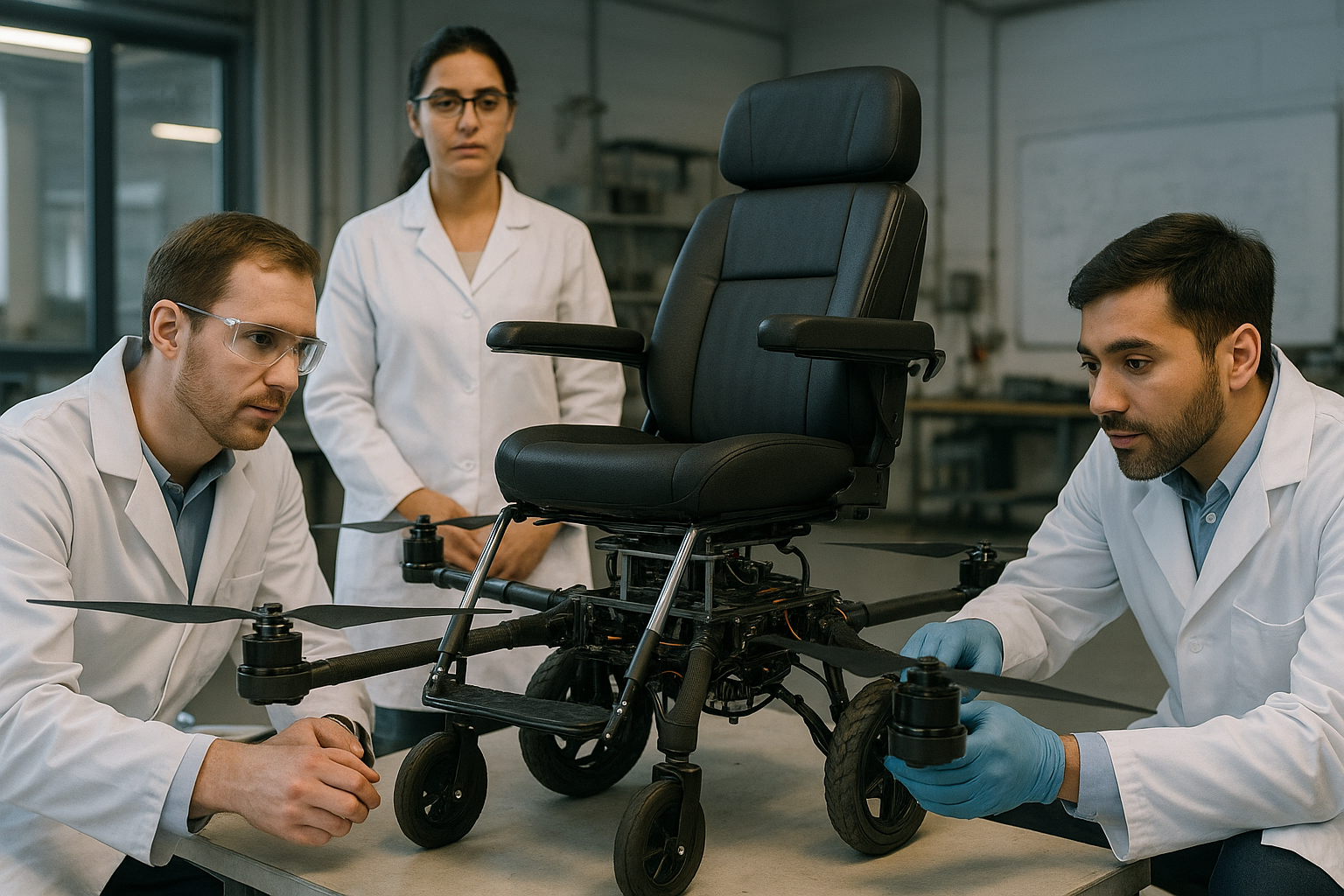Drone Wheelchairs to Become a Reality in the Future?

Technology is changing our world faster than ever before. From smart homes to self-driving cars, we are seeing new innovations every day. One of the most exciting and life-changing ideas gaining attention is the drone wheelchair. It may sound like something out of a science fiction movie, but believe it or not, drone wheelchairs could soon become a reality.
In this blog, we’ll explore what drone wheelchairs are, how they work, why they are important, and what the future may hold for this amazing invention.
What is a Drone Wheelchair?
A drone wheelchair is a new type of wheelchair that can fly like a drone. It combines the features of a traditional electric wheelchair with the flight capabilities of a drone. In simple words, it’s a flying wheelchair that uses powerful propellers and batteries to lift the person off the ground and carry them to their destination.
This kind of wheelchair is especially useful for people who face difficulties moving on rough terrain or stairs, or for those who want more freedom in their mobility.
While drone wheelchairs are still being developed and tested, some working prototypes already exist, and researchers are working hard to make them safe and practical for everyday use.
Why Do We Need Drone Wheelchairs?
Many people with physical disabilities face daily challenges that most of us don’t even think about. Here are some common problems they deal with:
-
Lack of wheelchair access in many buildings and public places
-
Difficulty using ramps or elevators in crowded areas
-
Barriers in outdoor areas like stairs, uneven roads, or sandy paths
-
Limited freedom to explore remote or natural areas
Drone wheelchairs could solve many of these problems. They can fly over obstacles, making it easier for users to go anywhere they want, anytime. This gives them more independence, freedom, and a better quality of life.
How Do Drone Wheelchairs Work?
The basic idea behind a drone wheelchair is simple: combine a lightweight electric wheelchair with drone technology.
Here’s how it works:
-
Propellers and Motors: Just like a drone, it has four or more propellers that spin fast to lift the wheelchair off the ground.
-
Battery-Powered: It runs on powerful rechargeable batteries, like those used in electric cars or large drones.
-
Joystick or App Control: The user can control it using a joystick, mobile app, or even voice commands.
-
GPS and Sensors: These wheelchairs use GPS for navigation and sensors to avoid obstacles and ensure a smooth ride.
-
Lightweight Frame: The body is made with carbon fiber or aluminum, which is strong yet light, making it easier to fly.
Some advanced designs may even include auto-pilot features, so the user can just select a destination, and the wheelchair will take them there safely.
Who is Working on Drone Wheelchairs?
Several companies and inventors around the world are exploring drone wheelchair technology. One of the most talked-about names is Khalid Abuleif, a Saudi inventor who introduced a flying wheelchair concept at a tech event. Another concept called “SkyLifter” also showed how flying devices could be used for personal transport.
While no company has yet released a commercial product for public use, the research is ongoing. Experts believe we may see working models for limited use (like in hospitals, airports, or tourist spots) in the next few years.
Are Drone Wheelchairs Safe?
This is one of the biggest concerns for both users and developers. After all, flying with a person in a chair needs to be extremely safe and stable.
Here are some key safety features being developed:
-
Auto-stabilizing systems to keep the wheelchair steady in the air
-
Obstacle detection to avoid crashes with walls or trees
-
Emergency landing systems in case of power failure
-
Backup batteries to provide extra power if needed
-
Weight sensors to ensure the device only lifts safe loads
Developers are also testing these chairs in controlled environments before allowing them in public spaces.
Challenges to Overcome
Even though drone wheelchairs sound amazing, there are still many challenges to solve before they become common:
-
Battery Life: Flying uses a lot of power. Current batteries may not last long enough for daily use.
-
Cost: The technology is still new and expensive. Making it affordable is a big hurdle.
-
Noise: Propellers can be loud, which may not be suitable for indoor or quiet areas.
-
Safety Rules: Most countries have strict laws about drones. Getting approval for flying devices that carry humans is difficult.
-
Training and Support: Users will need help to learn how to use these new devices safely.
However, just like smartphones and electric cars, these issues can be solved with time, better designs, and mass production.
What Benefits Can We Expect in the Future?
If drone wheelchairs become successful, they could change the lives of millions of people with mobility challenges. Here are some benefits we can expect:
-
Freedom of movement – go to places where regular wheelchairs can’t go
-
More independence – no need to rely on others for travel
-
Time-saving – fly over stairs, roads, or crowds
-
More social inclusion – enjoy travel, tourism, and outdoor activities
-
Boost in self-confidence – doing things once thought impossible
These benefits go beyond convenience – they bring hope and dignity to people who have long faced barriers in daily life.
The Future: When Will Drone Wheelchairs Be Available?
Right now, drone wheelchairs are still in the research and development stage. But the progress is promising. Some experts believe that within the next 5 to 10 years, we could see working drone wheelchairs in special areas like:
-
Hospitals
-
Airports
-
Tourist destinations
-
Large indoor shopping centers
Later, as the technology improves and becomes cheaper, we may see more personal drone wheelchairs being used in public.
Final Thoughts
Drone wheelchairs may sound like a dream today, but the future is closer than we think. With the speed of technology and growing interest in accessibility, we may soon see a time when people with physical disabilities can fly above barriers, not just roll past them.
These amazing machines could open up a new world of possibilities, offering more freedom, dignity, and adventure for people who need it most.
The journey is just beginning, but the sky’s the limit—literally.
Do you think drone wheelchairs will become common in our daily lives? Share your thoughts in the comments below!
